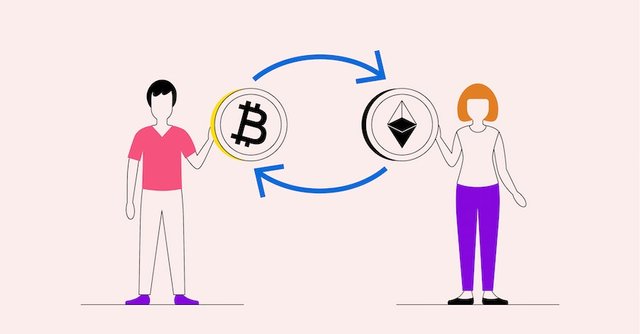Why Does The Emerging Blockchain Rely On Crypto Atomic Swapping
One of the most essential elements of the future blockchain economy is atomic exchanging off the blockchain.
An atomic swap is what?
An atomic swap is the peer-to-peer exchange of one cryptocurrency for another. A validator is all that is required to verify the transaction and add it to the blockchain. A validator could also bill a small fee for their assistance.
Let's imagine, for illustration, that your wallet has one ETH and mine has one BTC. I've wanted to purchase some ETH. By chance, you've also been planning to buy more BTC and are willing to sell ETH to get it. Because the DEX provides us with the values of each currency or token, I start the exchange through it so that the wallets can determine the appropriate exchange amounts for a fair trade. We both agree and select a validator to approve our transaction before it is added to the blockchain and verified. Our transaction is completed when the validator is paid a modest charge.The trade is all or nothing, which is why they are known as atomic swaps.
There are only two scenarios that could occur. The trade between the two parties must be successful, fail, and both parties keep their cryptocurrency. The other cannot be duped by either party.Let's look at the inner workings of an atomic swap to gain a better understanding.
How do Atomic Swaps function?
An atomic swap creates a seamless, secure, and private exchange by using two independent storage regions for each participant's cryptocurrency and giving the key to access those cryptos at the appropriate time.Money Talks was a film starring Chris Tucker and Charlie Sheen (1997).
One scenario features Chris passing something to Charlie and Charlie passing it back to him. I don't know you man, Chris says at the time of the encounter. the same time every day. Chris insisted that they trade their items simultaneously since he didn't trust Charlie and didn't want him to leave with both of them.To resolve the trust problem, atomic swapping was required, and here is how it would have operated.Chris is holding a clear box containing his thing and has a key to that box stashed away in his pocket. Charlie receives the box after Chris tosses it his way so he can see that it contains the object. Chris still possesses the key, therefore Charlie is unable to utilize the object. Charlie now displays the transparent box containing his object. Charlie's box, however, has the same lock as Chris'. After that, Charlie hands Chris his box.
The contents of each other's boxes have been confirmed by Chris and Charlie, but Chris still has the key in his pocket. The swap is complete when Chris removes the key from his pocket and shows it to Charlie and Chris.Both Chris and Charlie would be unable to open their boxes if they were to leave at any point. And when some time had passed, the things would be given back to their rightful owners. Additionally, Charlie and Chris will both be able to access their boxes when Chris pulls the key from his pocket, regardless of where he is.
Let's look at the advantages of atomic switching over centralized exchanges now.
A comparison of two cryptocurrency transfer methods between two walletsAtomic swaps and trading on centralized exchanges are comparable, however centralized exchanges require the user to go through a lot more processes and comply with KYC.To trade cryptocurrency through a centralized exchange, we must first get the cryptocurrency. Therefore, we buy it or mine it. Then, in order to alter the crypto pairs, we must use an exchange that deals in those pairs. We then need to complete the KYC procedure and register for the exchange.
The deal is then started, at a cost of a transaction charge. We are now awaiting the validation of the transaction. Once finished, we can exchange the cryptocurrency for money unless we intend to use it right away. Finally, there is a fee for the withdrawal if we do it in fiat. Afterward, we're done.When using atomic swapping, however, we start a trade with another user, select a validator, pay the validator a little amount in exchange for their services, and then finish the transaction. We're done now.
The similarities are obvious. Atomic swaps are the user's best option. And, in my opinion, the logical progression of what the cryptocurrency's monetary system ought to be.
With atomic swaps, users have control, which is what Satoshi desired.We ought to all support atomic swapping.

Nice example and explanation. Thanks for sharing.
I'm happy you've enjoyed my content, I'll keep making great and quality crypto related contents
Thank you